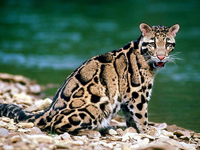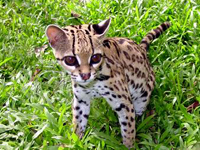

 |

|
 Ocelot |
Ocelot(Mammal) |
 Ocelot Baby |
Ocelot HabitsThe ocelot inhabits both scrubland and forest. Forest-dwelling ocelots have rich, golden-colored coats that blend in with the golden-brown hue of the trees. Ocelots that live in scrubland have duller, grayish-colored coasts that provide camouflage from predators.
An agile climber, the ocelot spends much of its time resting in trees. Unlike domestic cats that can run down trees headfirst, the ocelot climbs down backward.
The ocelot is territorial and marks it the boundaries of its territory by spraying trees with urine. Most ocelots are solitary, but some form pairs.
Dark blotches on a rich golden or silver base. Perfect for its equatorial forest habitat. Each cat is suited to its environment: the leopard to the dry tropical forest, and the cheetah to the arid savanna. The ocelot is about a third the length of the Bengal tiger. By comparison, a domestic cat is much smaller then the other two. |
Ocelot CommunicationThey communicate by using scent markings. They also growl and meow when in heat. |
Ocelot BreedingIt is not know for certain when and how often the ocelot breeds. It is thought that it breeds twice a year, in summer and in winter. When the breeding season arrives, the ocelot will venture out of its territory to find a mate. The female starts the courtship by calling loudly to attract a male. During mating, the male holds the female by the back of the neck. an ocelot
Before the kittens are born two months later, the female makes a well-hidden nest. This is sometimes lined with soft down plucked from her underside.
Two to four kittens are born. As each one arrives, the mother breaks the birth sac to free the kitten. She bites off the umbilical cord and licks the newborn clean and dry, then eats the afterbirth.
The kittens are born with fur, but they are blind and helpless for several days. Therefore, the mother will leave them only when absolutely necessary. for the first few weeks, the kittens feed only on their mother's milk. During this time, she will eat their droppings so as to keep the nest clean.
When the kittens are older, the mother brings them live prey and teaches them how to kill it. Later they follow her on hunting trips to develop their skills. Once the kittens become competent hunters, they leave the nest to find their own territories. |
Ocelot Food & FeedingAlthough its sense of smell is highly developed, the ocelot relies more on its hearing and eyesight to detect prey, which it hunts at night. The hearing of small cats like the ocelot is more acute than that of larger cats, and they are better able to pinpoint the location of their prey. Its whiskers are also important to the ocelot when hunting. They a re so sensitive to touch that they help the cat maneuver in tight spaces.
The ocelots' prey includes agoutis, hares, mice, monkeys, and birds. Although it spends a lot of time in the trees, all hunting is done on the ground. It will lie flat on its stomach once prey is spotted. It will slowly creep forward in this position and then rush at the prey over a short distance before pouncing the catching it with its razor like claws. The ocelot sharpens its claws by scratching them against tree trunks.
The prey is killed quickly with a bite to the neck. Small prey is devoured headfirst, but with large prey, the ocelot begins eating at a soft part of the animal's body. |
Ocelot Key Facts |
| Size |
| Height: Body length: 25-40 inches. Tail length: 10-16 inches |
| Weight: 25-35 pounds |
| Breeding |
| Sexual maturity: 6-8 months |
| Mating: Once or twice a year, depending on location |
| Gestation: 70 days |
| Number of young: 2-4 kittens |
| Lifestyle |
| Habit: Solitary or may live in pairs |
| Diet: Agoutis, hares, mice, monkeys, and birds |
| Lifespan: 17 years in captivity. Unknown in wild |
DID YOU KNOW?
|
CAN'T FIND WHAT YOU'RE LOOKING FOR? CLICK HERE!!!